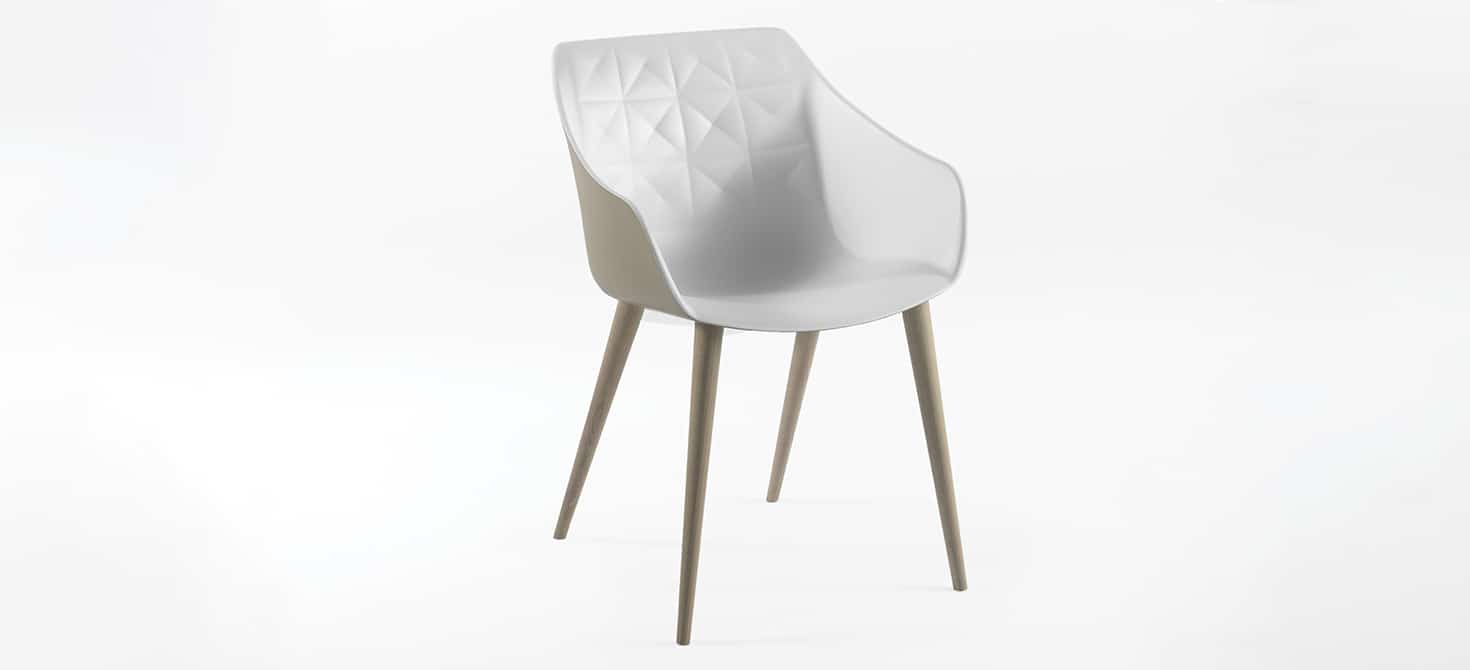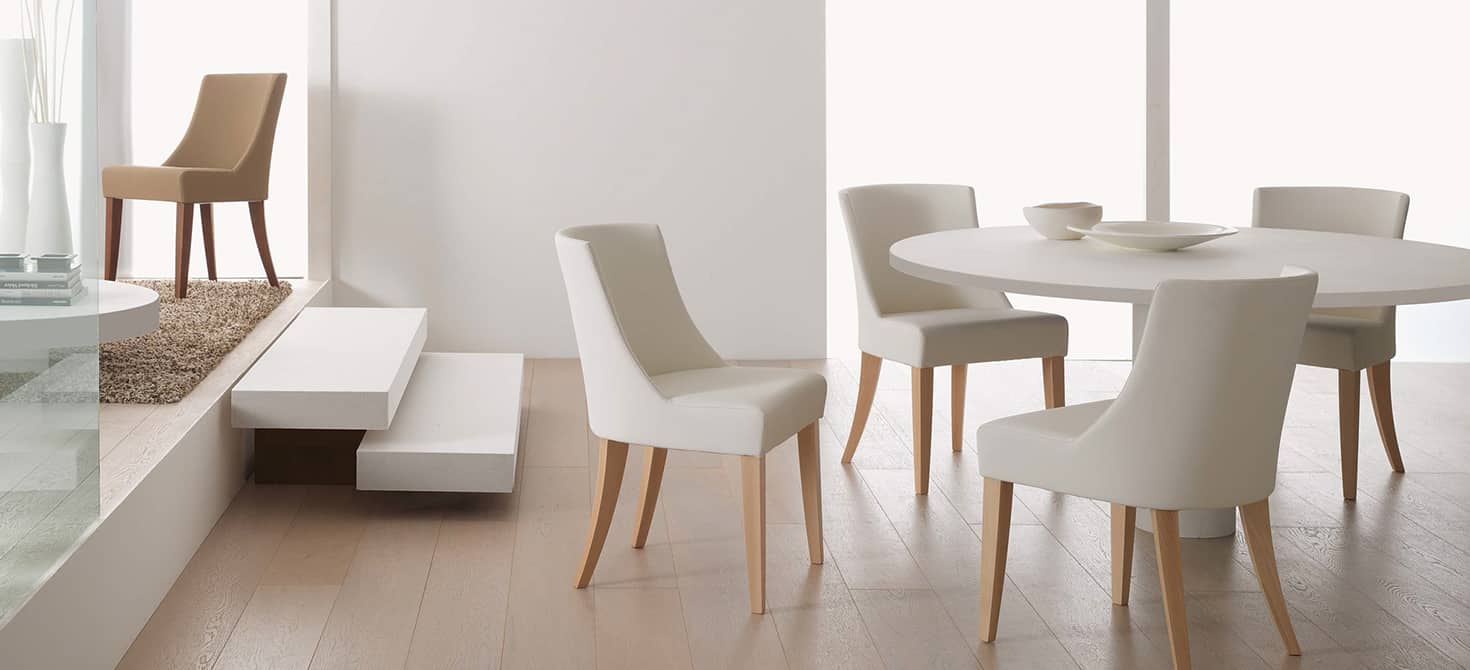- Matching furniture
- 0 likes
- 5783 views

In this article we will talk about the main types of chairs, with particular reference to materials and fabrics used to make these furnishings. When choosing a quality chair for your home or professional environment, it is always important to pay due attention to the use of materials and fabrics. This is not only a question of style and design, but also and above all of the quality of the furniture, its solidity, resistance and safety.
Here's everything you need to know about the subject.
Index
How to choose a chair according to its material
When choosing a chair that suits your needs and requirements, the material it is made of is undoubtedly an aspect of fundamental importance, and should therefore be considered with the utmost care. The material with which a chair is made must be able to guarantee maximum stability and safety, as well as a high standard of comfort.
In the following paragraphs we examine the main types of chairs available on the market, based on the different materials used for their realisation.
Rigid chairs
Rigid chairs represent one of the large categories available on the market: these models are made with the help of different materials, which can give the furniture great solidity and safety. A rigid chair may be made with the use of metal, wood, plastic, or alternatively a combination or mix of several materials.
Rigid metal chairs and plastic chairs tend to be conceived to be arranged in the context of an indoor or outdoor space. Wooden chairs, on the other hand, tend to be suitable for predominantly indoor use: it is good to specify, however, that thanks to the aid of special treatments of this natural material, today wooden chairs are also available on the market that are suitable for outdoor use in gardens, terraces or balconies.
Today the market is able to offer us a vast range of solutions for rigid chairs, capable of responding to every single requirement and specific need, both from an aesthetic and technical point of view.
Plastic probably represents one of the most typical and common materials with which rigid chairs capable of responding to good quality standards are produced today. If you intend to choose and purchase a rigid plastic chair that represents the perfect quality/price ratio, we recommend the Cester + Wood model: this fantastic model of rigid chair/armchair is a piece of furniture purposely conceived and studied to be soft to the eye, despite being constituted and realised with the aid of a rigid material such as polyurethane. The elegant shapes of this armchair model, combined with the presence of beech wood legs, make this piece the ideal furnishing solution for a modern and dynamic home environment (kitchen, living room or bedroom).

Upholstered chairs: how to choose the covering
Another type of seating available on the market, in a wide range of models, is represented by padded chairs. Upholstered chairs are an extremely practical and elegant solution for completing the home furnishings. These models of chairs are still very trendy and up-to-date today.
In this regard it is important to specify how the combination of the seat model and the ideal fabric will allow you to adapt your chairs to furnishing contexts characterised by the most diverse styles. At this point it is inevitable to ask oneself how to choose the fabrics for the covering of the chairs? Let us try to answer this question in a precise and exhaustive manner.
When it comes to choosing the covering of a chair, the options will be the most disparate: we can in fact choose fabrics for classic chairs, fabrics for vintage chairs, or even fabrics for stain-resistant chairs and much more.
In the choice of the best covering for a chair it will first of all be necessary to consider what type of chairs we are going to upholster (types of antique chairs, types of modern chairs, etc.). The materials for upholstering chairs available on the market today are truly numerous.
Since there are so many variables available, the most important thing in choosing the best upholstery for your seat is to consider, even before the seat model, some factors of fundamental importance, and in particular:
- The frequency with which you intend to clean the seat upholstery
- The average duration of the chair (and its covering) you are going to purchase
- The intended use of the chair and the environment in which it will be placed (kitchen, living room, bedroom, etc.)
- The furnishing style and design that characterise your environment
- Whether you prefer a stiffer chair or an extremely soft one
- The adaptability of the colour of the fabric you are choosing in the context of the rooms in your environment
In general terms, as far as chair covers are concerned, we can say that cotton represents a material of great quality. The risk, however, is represented by the fact that this material may stain very easily: for this reason, it is better not to choose chairs covered in cotton for a restaurant or bar activity. In this furnishing context it may be more suitable to choose a washable fabric, and if possible also waterproof (synthetic or natural).
The variables that you will have to take into account when choosing the best cover for your chair will also have to consider some additional aspects, linked to the safety of your environment. For example, in restaurants, theatres, conference rooms and places where many people are concentrated, fire-resistant seat covers are usually used. These covers are not made with the help of dyes and colours in which heavy metals or azo dyes are present.
When choosing a chair upholstery or cover, you should basically consider the fact that textured fabrics are certainly more comfortable and convenient, since they are breathable. Leather and artificial leather, on the other hand, are compact coverings that are not able to absorb the moisture produced naturally in contact with the body.
Fabrics for upholstery can be classified respectively into natural and artificial fibres: here is all you need to know about them
Seat covering: natural fibres
The natural fibres commonly used for the upholstery of chairs derive from the processing of materials normally present in nature. Natural fibres can in turn be subdivided into:
- fibres of animal origin
- fibres of vegetable origin
Animal fibres are obtained from the hair of various species (wool, cashmere, silk or leather).
Fibres of vegetable origin, on the other hand, are products obtained from the processing of plants and plant species, such as cotton, linen or hemp.
Seat coverings: artificial fibres
Artificial fibres are another category of products used to make seat covers. Artificial textile fibres are a category of products created in a laboratory, using only part of the raw material of natural origin (cellulose). A series of man-made chemicals are added to the natural raw material.
Artificial fibres should not, however, be confused with synthetic fibres, as the latter are not composed of natural parts, but of products derived from oil processing.
Examples of artificial fibres are viscose modal and aceton. Nylon, Lycra, polyester and PVC are synthetic fibres.
Microfibre also falls into the category of synthetic fibres, since it is made from nylon, polyester, polyurethane foam or a mixture of these fibres. However, microfibre is a fabric that can boast a good standard of softness of touch, pliability and resistance.
Yemen Chair, a piece of furniture with high quality microfiber covering
If you are willing to buy a chair made with microfiber covering, our advice can only be to buy the fantastic Yemen Chair model: it is a model that expresses itself in a unique and inimitable design, composed by beech wood legs available in natural, natural oak, medium walnut, dark walnut, wenge and black colours.

The seat of this furniture is also available in different finishes: soft touch effect, nubuck effect, animal skin effect and fireproof microfibre. Yemen chair, besides being the perfect furniture for an office or a working place, represents an ideal model to complete the furnishing of a domestic environment, and in particular of a living room, a kitchen or a study.
